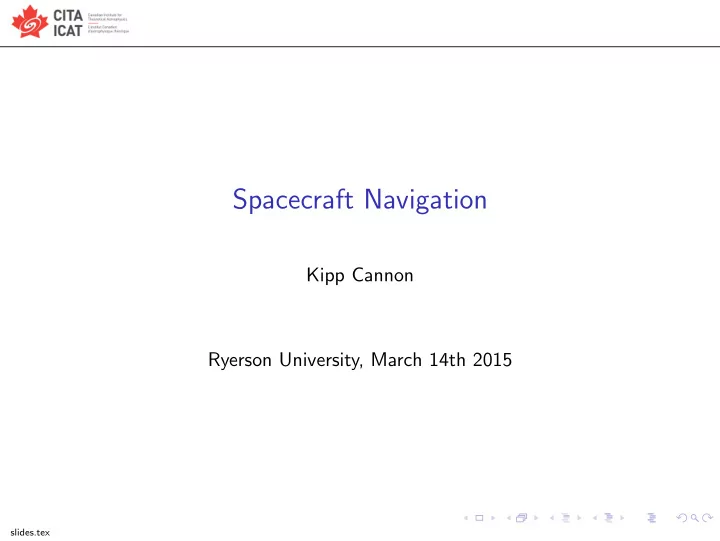

Spacecraft Navigation Kipp Cannon Ryerson University, March 14th 2015 slides.tex
Challenges ◮ Distance: light travel time forces spacecraft to be autonomous, repair is not possible so robustness and exhaustive pre-flight testing is essential. ◮ Distance to space station: 400 km = 1 ms . ◮ Distance to Moon: 384 . 4 × 10 3 km = 1 . 28 s ◮ Distance to Sun: 149 . 6 × 10 6 km = 500 s ◮ Distance to Mars upon arrival on Hohmann transfer orbit: ∼ 14 min ◮ Current distance to Voyager 1: 19 . 4 × 10 9 km = 18 h slides.tex
Challenges ◮ Speed: not possible to carry enough fuel to significantly alter course, so only small corrections are possible after initial launch ◮ “Sound barrier” = 0 . 3 km / s ◮ Low Earth orbit (LEO) requires a speed of 8 km / s = 29 × 10 3 km / h ◮ Leaving the Earth requires a speed of 11 km / s = 40 × 10 3 km / h ◮ Leaving Mars requires a speed of 5 km / s = 18 × 10 3 km / h ◮ Leaving the Solar system (starting at Earth) requires a speed of 42 km / s = 151 × 10 3 km / h slides.tex
Challenges ◮ Precision: enormous distances travelled and inability to make significant course changes along the way forces guidance system to be extremely precise. slides.tex
Challenges ◮ Absence of local reference: no solid ground or even atmosphere with which to measure the effects of flight control actions e.g., pressing gas in car doesn’t always result in forward movement, but by observing through window it is usually easy to determine if it has or not. slides.tex
Challenges ◮ Relativity: space and time are curved so radio signals do not follow straight lines in our solar system, clocks at different locations do not run at the same speeds, and the large speeds of spacecraft also cause clocks to run at different speeds. ◮ Not important for people, but important for precision navigation. slides.tex
Elements of Spacecraft Navigation ◮ Spacecraft only rarely burn fuel, so flight is almost entirely pure orbital motion — free-fall under the influence of gravity alone. ◮ Using knowledge of the physical laws governing orbital motion, only a small number of measurements are needed to determine the spacecraft’s location and trajectory: ◮ primary tool is distance from Earth and rate of change of distance. ◮ in some cases position on sky (e.g., using radio interferometers or by timing occultations) ◮ for attitude control spacecraft generally measures apparent positions of planets and/or stars from its location (e.g., wrt background stars or wrt its instruments) ◮ the latter also allows for position determination but not as accurate as ground-based range/range-rate measurements. slides.tex
Tools ◮ On-board star sighting telescopes. ◮ On-board planetary limb cameras. ◮ Most important: radio range finding ◮ Coherent link with coded pulses is established with spacecraft and monitored over a period of time. ◮ Allows distance to be measured to ± 1 m . ◮ When things go wrong: ◮ Loss of attitude leads to misalignment of high-gain antenna with Earth — no longer possible to communicate, loss of radio ranging. ◮ Spacecraft carries backup omni-directional antenna — can communicate in all directions but with very bad quality signal. ◮ Compensate with enormous powerful transmitter on Earth and blast command signal to spacecraft to try to correct attitude. ◮ Goldstone antenna has 500 kW transmitter on 70 m dish. slides.tex
Take-Away Message ◮ It’s not easy. ◮ There aren’t any tricks for making it easier. ◮ Relies very heavily on understanding of physics: spacecraft motion is mostly inferred using knowledge of physics. slides.tex
Interstellar Navigation ◮ Obviously never attempted. ◮ Radio ranging from Earth is impractical due to vast distances. ◮ Might be possible to use pulsars as navigation beacons, use quasars for attitude reference and cosmic microwave background for velocity reference. ◮ Techniques are mostly speculative, but there is research on this problem. slides.tex
Recommend
More recommend